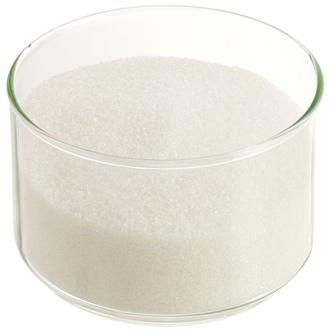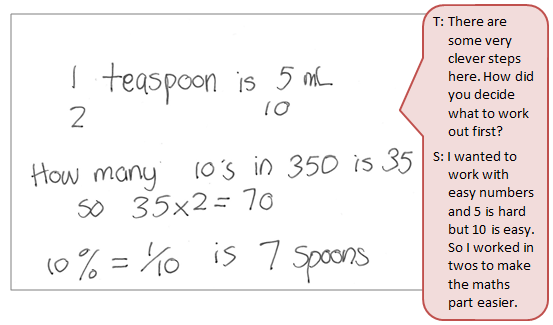The purpose of this activity is to engage students in applying their number knowledge to solve a measurement problem.
This activity assumes the students have experience in the following areas:
- Finding multiples of ten and five.
- Multiplying and dividing by ten.
- Working with simple percentages like 50%, 25% and 10%.
- Measuring volume (capacity) using litres (L) and millilitres (mL).
The problem is sufficiently open ended to allow the students freedom of choice in their approach. It may be scaffolded with guidance that leads to a solution, and/or the students might be given the opportunity to solve the problem independently.
The example responses at the end of the resource give an indication of the kind of response to expect from students who approach the problem in particular ways.

A 350 mL can of soft drink says that it contains 10% sugar.

One teaspoon contains 5 mL.
Work out how many teaspoons of sugar are in one can of this drink.
The following prompts illustrate how this activity can be structured around the phases of the Mathematics Investigation Cycle.
Make sense
Introduce the problem. Allow students time to read it and discuss in pairs or small groups.
- Do I understand the situation and the words? (Students may need support to understand the meaning of 10% sugar. In this case, it is assumed that 10% relates to volume.)
- What are the important words and symbols? (mL refers to millimetres which are one thousandth of 1 litre. 10% is 10 parts in every 100 or one tenth.)
- What will my solution look like? (The solution will give the number of teaspoons of sugar in the 350 mL can, supported and justifies using correct calculations.)
- Do I have all the information that I need, or do I need to look for information?
Plan approach
Discuss ideas about how to solve the problem. Emphasise that, in the planning phase, you want students to say how they would solve the problem, not to actually solve it.
- What are the maths skills I need to work this out?
- How will I record my workings so I don’t miss anything and can check my answer is correct?
- What strategies can I use? Is drawing a diagram helpful? Should we make a list/table?
- What calculations will I need?
- What might the answer be? Can I make a sensible estimate?
- What tools (digital or physical) could help my investigation? (Access to measuring containers and teaspoons will be important for some students.)
Take action
Allow students time to work through their strategy and find a solution to the problem.
- Have I recorded my ideas in a way that helps me to see patterns?
- Are there any patterns?
- How might I describe the pattern?
- Does the pattern help me to answer the question?
- Is my strategy working well?
- How do my results look different to others? Why could this be?
- Does my solution make sense? Does it match my estimation?
- Does my solution answer the question?
- Is there another possible way to solve it that is more efficient?
Convince yourself and others
Allow students time to check their answers and then either have them pair share with other groups or ask for volunteers to share their solution with the class.
- What is the solution? Does the solution seem sensible? Could I defend it?
- Is my working clear for someone else to follow?
- How would I convince someone else I am correct?
- Could I have solved the problem in a more efficient way?
- Which ideas or tools worked well in my investigation?
- What could I try differently next time?
- What could I find out next?
Examples of work
Work sample 1
The student applies the distributive property to partition 350 mL into two amounts of 300 mL and 50 mL. They find 10% of each amount by dividing by ten and add the results to get the total amount of sugar in 350 mL of drink.
Click on the image to enlarge it. Click again to close.
Work sample 2
The student converts between teaspoons and millilitres to find the number of teaspoons in 350 mL. They calculate conversions using multiplication and division.

